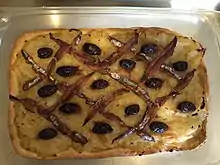 Typical pissaladière from Nice | |
| Alternative names | Pissaladiera, pissaladina, piscialandrea, pizza all'Andrea, |
|---|---|
| Type | Focaccia, Fougasse |
| Place of origin | |
| Region or state | Provence |
| Serving temperature | Warm, cold |
| Main ingredients | Bread dough, onions, olives, garlic, anchovies or pissalat |
| Part of a series on |
| Pizza |
|---|
Pissaladière (UK: /ˌpɪsælædˈjɛər/, US: /ˌpiːsɑːlɑːdˈjɛər/,[1][2] French: [pisaladjɛʁ]; Niçard: pissaladiera [pisalaˈdjeɾɔ] or pissaladina [pisalaˈdinɔ]; Ligurian: piscialandrea [piʃalaŋˈdɾeːa] or sardenaira) is a dish of flatbread with toppings from the region of Provence[3] and the French city of Nice.[4][5] It is often compared to pizza. The dough is usually a bread dough thicker than that of the classic pizza Margherita, and the traditional topping in Nice usually consists of caramelised (almost pureed) onions, black olives (generally caillettes) and anchovies (whole, and sometimes also with pissalat, a type of anchovy paste).[6]
Etymology and History
The etymology of the word seems to originate from the Latin piscis "fish",[7] which in turn originated pissalat, the name of an anchovy paste[6] (via peis salat, "salted fish" Niçard).[8]
The first written recipe was found in a document of the year 879 in Provence. This old recipe included onions and pissalat, confirming that the name derives from this anchovy puré.[9]
Description
The dough is usually a bread dough thicker than that of the classic pizza margherita, and the traditional topping usually consists of caramelised (almost pureed) onions, black olives, and anchovies (whole, and sometimes also with pissalat).[6] In the version of Menton the dough is enriched with tomatoes.
Some other variants exist in France:[10]
- The pichade, typical from Menton, is a pissaladière with a tomato base.
- The tarte de Menton is a pissaladière without anchovies.
See also
References
- ↑ "pissaladière" (US) and "pissaladière". Oxford Dictionaries UK English Dictionary. Oxford University Press.
- ↑ "pissaladière". Merriam-Webster.com Dictionary. Retrieved 18 May 2019.
- ↑ Larousse, Librairie (2009-10-13). Larousse Gastronomique: The World's Greatest Culinary Encyclopedia, Completely Revised and Updated. National Geographic Books. ISBN 978-0-307-46491-0.
- ↑ o-yummy (2020-05-08). "Pissaladière". O-yummy. Retrieved 2023-06-11.
- ↑ Grigson, Jane (2007-04-01). Jane Grigson's Vegetable Book. U of Nebraska Press. ISBN 978-0-8032-5994-2.
- 1 2 3 Julia Child (1961) Mastering the Art of French Cooking Vol. 1, Alfred A. Knopf, New York
- ↑ David, Elizabeth (1999). A Book of Mediterranean Food. London: Grub Street. pp. 38/39. ISBN 1-902304-27-6.
- ↑ Benvenuto, Alex. Les cuisines du Pays niçois, Serre éditeur. Nice: 2001. ISBN 2-86410-262-5
- ↑ Herment, Raymond (1952-01-01). Au royaume de la fée Diane d'Estérel: Théoule, son histoire, ses légendes (in French). FeniXX réédition numérique. ISBN 978-2-402-19191-3.
- ↑ Gaudry, François-Régis (2018-10-16). Let's Eat France!: 1,250 specialty foods, 375 iconic recipes, 350 topics, 260 personalities, plus hundreds of maps, charts, tricks, tips, and anecdotes and everything else you want to know about the food of France. Artisan Books. ISBN 978-1-57965-876-2.
External links
- Recipe courtesy Emeril Lagasse, 2002
- Delia Smiths's recipe, with UK & metric measures
- Flo Braker's variant, with cheese